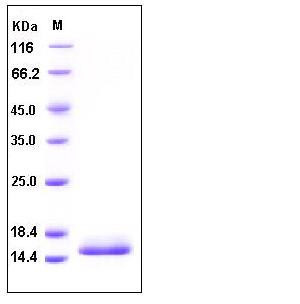Human Cystatin D / CST5 Protein (His Tag)
CST5,MGC71922
- 100ug (NPP2064) Please inquiry
| Catalog Number | P10506-H08H |
|---|---|
| Organism Species | Human |
| Host | Human Cells |
| Synonyms | CST5,MGC71922 |
| Molecular Weight | The secreted mature recombinant human CST5 comprises 133 amino acids with the predicted molecular mass of 15.2 kDa as estimated by SDS-PAGE under reducing conditions. |
| predicted N | Gly 21 |
| SDS-PAGE |  |
| Purity | > 95 % as determined by SDS-PAGE |
| Protein Construction | A DNA sequence encoding the pro form of human Cystatin D (NP_001891.2) (Met 1-Val 142) with a C-terminal polyhistidine tag was expressed. |
| Bio-activity | |
| Research Area | Cancer |Signal transduction |Cellular Senescence and Pathways in Aging |Apoptosis |Caspase & inhibitor |Caspase inhibitors | |
| Formulation | Lyophilized from sterile PBS, pH 7.4 1. Normally 5 % - 8 % trehalose and mannitol are added as protectants before lyophilization. Specific concentrations are included in the hardcopy of COA. |
| Background | Cystatins are natural inhibitors of papain-like (family C1) and legumain-related (family C13) cysteine peptidases. The mammalian cystatin superfamily members are of three major types, including the type 1 cystatins (stefins), type 2 cystatins and the kininogens. As a member of type 2 cystatin, cystatin D is a single-domain protein and also has cysteine residues that form disulfide bridges. In contrast with the wider distribution of all the other family 2 cystatins, cystatin D is tissue-restricted expressed and has been found only in saliva and tears. and meanwhile, it displays an inhibition profile with a preferential inhibition on cathepsin S, H, L. Although the exact functions are largely unknown, it has reported that cystatin D is involved in the inhibition of virus replication and apoptosis. |
| Reference |
